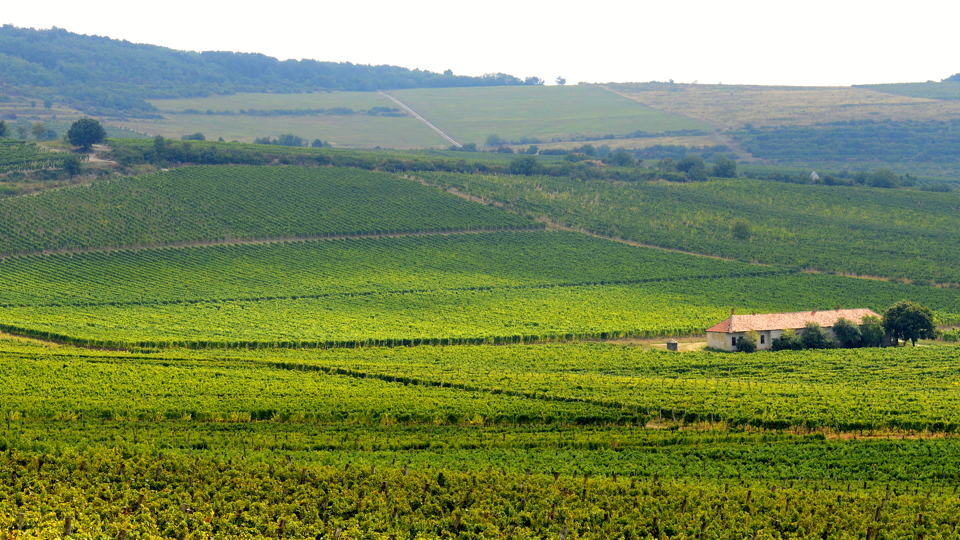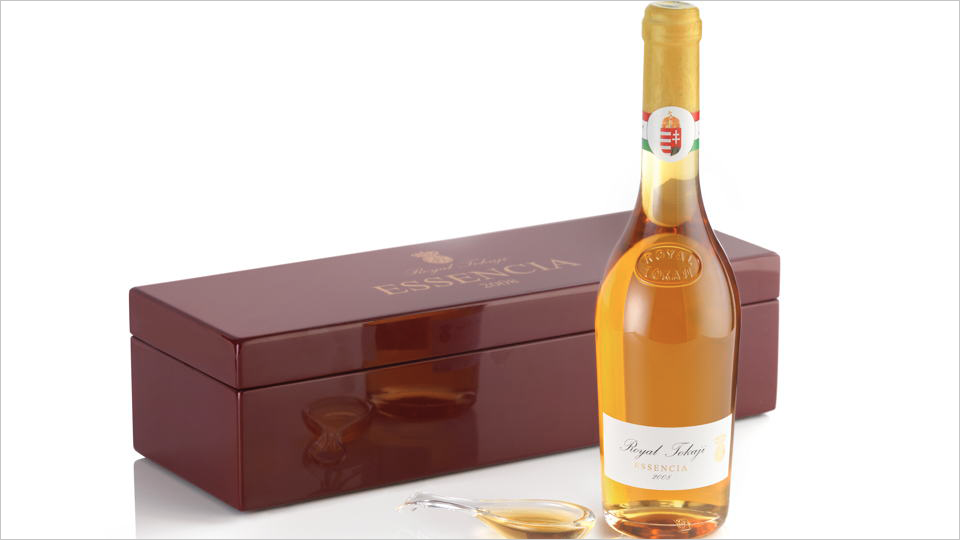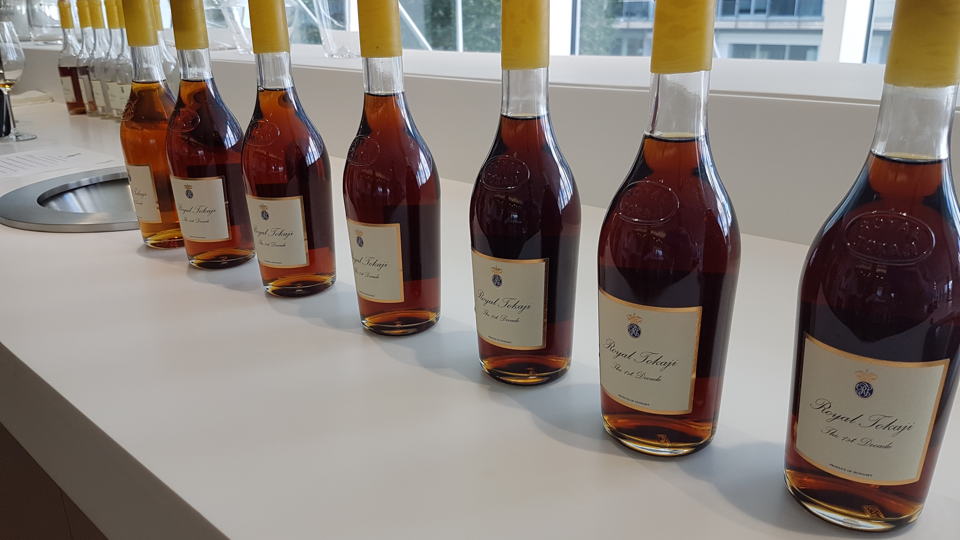Browse using the new Vinous website now. Launch →
Printed by, and for the sole use of . All rights reserved © 2015 Vinous Media
Mád Idea: Royal Tokaji 1990-2013
BY NEAL MARTIN | JULY 03, 2019
You might assume that the oldest bottle of wine I have ever tasted is the 1760 Terrantez included in my Madeira report in early 2019. You would be wrong. The oldest bottle, or more accurately bottles, that I have tasted were even more ancient, and they were not Madeira but Tokaji. You can read all about them at the end of this article, which also travels back in time, though not three centuries but three decades, to the dawn of the modern age for Tokaji and the inception of the Royal Tokaji Wine Company. Hugh Johnson’s involvement gave the resurrection impetus and a globally renowned figurehead, and meeting him again at this tasting, I could see that his unbridled enthusiasm remains undiminished. Along with general manager Zotlán Kovács, who transferred from the Disznoko in January 2017, Johnson and I examined the first vintages from the 1990s that are being re-released, as well as the latest release, at Farr Vintners’ offices in London.
I have transcribed Johnson’s commentary and blended in extracts from an interview that I conducted in 2005, when he offered personal insights into the challenges faced by an Englishman entering a country in the throes of crumbling communist rule.

Zotlán Kovács and Hugh Johnson.
A Mád Idea
“My Tokaji experience began in 1970,” Johnson explained in his unmistakable scholarly tone. “I was aware that one of the world’s greatest wines was stuck behind the Iron Curtain. I always had in mind to do something about it, and the opportunity arose in 1989, when communism was on the skids and the Hungarian prime minister opened the border. I could see that everything was changing. Together with friends that included Danish bankers and Hans Vinding Diers, we went to [the town of] Mád because all the dealers were there. It was a business town with a large Jewish community and wonderful vineyards. We were tipped off that good wines were being made by individual growers, but when I first started going, it was very undeveloped. It is impossible to exaggerate the deprivation. I wondered where I was going to sleep and eat and used to say that Budapest was lit by one 40-watt bulb.”
“We decided on the name Royal Tokaji. We thought it was catchy, and it referred back to the royal history, rather than Imperial Tokaji, which refers back to the Habsburgs. The pride of Hungary is tied up with the royal house rather than the emperor. I went round growers asking for samples but there were no bottles, so we went to bars and used empty Coke bottles. We avoided the state-owned cooperatives, which just produced brown fluid that was bottled in other cities. The shining light was a few growers who made a handful of barrels for themselves, and these barrels were hidden almost literally under the stairs. So we dug in and asked the farmers in Mád if they would help us and contribute towards a collaborative brand. Samuel Tinon was working in Entre-Deux-Mers when Vinding Diers invited him to supervise the first harvest in 1990. We did not have a winery, the press was in the open air and we had to rent cellar space. We also had to refuse a lot of trailers that contained poor fruit.”
“Each new vintage we learned something from the last. We discovered that it was far from straightforward, and we had to work out for ourselves how to create the wine we wanted. There were conflicting reports about that age-old argument of old-style or new-style Tokaji. Our goal was to pursue the style of Tokaji that I fell in love with. Personally, I thought that Aszú was Tokaji’s greatest wine and rather ignored the rest, so initially our company decided to make Aszú only. Since then we have back-pedaled, and we make non-Aszú wines in poorer years. You are not guaranteed Aszú grapes every year and they are a huge amount of trouble to make. They are not everyday wines.”
Vineyards
The Royal Tokaji Company is known for its pioneering use of vineyard sites, so here is a brief summary of those included in this report.
Betsek is a 16-hectare vineyard southeast of Mád, the vines located on black volcanic topsoil. The Royal Tokaji website states that Betsek has been served to Putin, although no tasting notes have been forthcoming from the Russian president. It tends to contain more Hárslevelű than other vineyards and is slightly spicier in style.
The Birsalmás vineyard, which
means “quince” in Hungarian, lies just outside Mád on a southeast-facing
incline. It is just 0.5 hectares in size and produces only around 1,800
bottles. Johnson himself described the Mézes Mály vineyard when he launched
the 1993 a few years ago. “Mézes Mály is an unusual vineyard. It is a name that
has cropped up again and again throughout history, since 1571. It is an outcrop,
a peculiar piece of vineyard on the northern outskirts of Tarcal at a lower
elevation than most, isolated from the other great growths and with a different
soil. Most have stony clay called nurok
that produces late-ripening, high-acid wines. However, on the lower slopes you
have more or less stone-free loess, which dries out, so you don’t really want a
vintage like 2000. In the average vintage, you get a wine with a certain
perfume, although it may not be the longest-lasting wine. The 1993 was our
first vintage and the first time the name had appeared on a label for maybe a
century. One of things about loess soil is that it is wonderful for Muscat
d’Alexandria, so we have a higher proportion than anybody else, perhaps 15%,
and we are planting more.” Nyulászó is an 18-hectare
vineyard located east of Mád, adjacent to the Szt. Tamás vineyard. The literal
translation of its name is “to catch hares.” The vineyard is marked by red
volcanic topsoil that engenders lively wines. Szt. Tamás comprises 12 hectares of vine orientated south, southwest and southeast
within the commune of Mád. It is planted entirely with Furmint.

The Betsek vineyard where the vines are located on black volcanic topsoil.
Winemaking
“The river itself does not make a great deal of difference to the atmosphere. It’s a wide river, and it’s the flood plain that creates the atmospheric conditions for botrytis. At Royal Tokaji the harvest traditionally starts on October 23, very late for a European harvest, and at that point, if you are going to get botrytis then you will already have it. You go into the vineyard starting as late as you dare. Every picker carries two buckets, one for the botrytis-affected berries that are picked berry by berry and the other for unaffected juicy, green berries. If the whole bunch is affected with botrytis, then you put the whole bunch in. Yields are very low. We consider 10hl/ha a big crop. Both buckets go back to the winery and you press the green grapes, settle for two or three days and ferment them. Meanwhile you keep the Aszú to one side. We learned that how you keep the Aszú is very important. In the early 1990s the rich Aszú attracted all manner of insects and flies, so you scattered on some SO2 and blended the Aszú in a hurry. So we built cold storage where the Aszú grapes could be kept, and they can stay there as long as we like whilst we make the wine in quite a leisurely fashion.”
“We cool-ferment the first wine at 16–18°C for between 21 and 25 days, as we want a slow fermentation to make aromatic wines. Then we soak in the Aszú, and here you can be generous: one ton of Aszú per 1,000 liters of wine, roughly half and half. Some of the modern theorists want freshness – the French in particular, who create a more Sauternes style of wine and add the Aszú to the unfermented must. But we found that there is a big difference between soaking the Aszú paste after fermentation rather than when the must is alcohol-free. It creates a different process. The must does not obtain the same level of sugar out of the Aszú and it doesn’t extract the same flavors, so you get a mild-tasting result. You do not get that hit and tang, which is the very essence of Tokaji.”
“The first time you add the Aszú, you have the richest result, and this usually goes to make the 6-Puttonyos or Essencia. We then repeat the process, adding more fermented wine – up to three times, so you have three qualities. By the third you have the sugar but not quite the extract, and this goes into our entry-level wine. The most extraordinary thing is the two kilometers of medieval cellars. They are pitch dark and completely covered in mold, colder and damper than almost any European cellar that I have been to. Such conditions create very slow reactions between wine and atmosphere. From 2010 we changed the oak regimen so that it has less influence, using second- and third-fill barrels that are 300 and 500 liters in size. We use more new oak for the single-vineyard.”
Essencia
Hugh Johnson offered me his own personal view on Essencia, the wine that is in fact not wine. “Essencia [sometimes spelled Eszencia] is made from the drops of very sweet juice that emerges from Aszú grapes which have essentially lost their skins entirely and therefore there is nothing to hold the juice in. The first vintage I was involved in, we had a lot of Aszú and nowhere to put it. So we put it into plastic bins in the cellar, lined them with plastic sheeting and put a system of plastic drainpipes at the bottom, so that the juice found its way down into a plastic jerry can. It is incredibly viscous with sugar content that I have seen up to 85%. It is almost unfermentable. You can drink it straightaway or wait for development. The law states that it should be a minimum of 5% alcohol, which is ridiculous, as it never happens. At Royal Tokaji ours is about 2%. It is not strictly wine and for that reason the historic Essencias that were drunk by the Tsars were probably made into more of a "drink" by adding brandy or spirit. Certainly when I went into the state cellars in the 1970s, I asked the old cellarmaster and he told me that of course they added brandy, as customers wanted something stable that was drinking. The Tsar would not have been impressed if there was no alcohol in it.”

Bottles of Essencia are rare and expensive. Royal Tokaji releases them in lacquer boxes with a clear glass spoon. The cutlery is not for show; trust me when I say that Essencia tastes far better when drunk from a spoon, like a child being given medicine.
Vintages
Zotlán Kovács summarized the earliest vintages from the Royal Tokaji Wine Company.
“Nineteen-ninety was a small, classic vintage with a dry summer and a cold, rainy autumn. Harvest began with a limited amount of Aszú berries that came more toward the end. The 1992 vintage was not the best in Tokaji. Summer was cold and rainy. Harvest was delayed and the best fruit was picked in late November. We thought that 1993 was the vintage of the decade at the time because the wines had great complexity and structure. We started picking in September and finished in late October. In this year the company decided that they should make a 6-Puttonyos in order to show the potential of the vineyards, and we were the first producer to use individual vineyard names. These will see eight years in barrel. It was also the first vintage made completely on our own premises. The 1995 vintage saw an early summer and warm conditions with welcome rains at the beginning of September. The 1996 vintage is good-quality though it was more wet and rainy during summer and autumn – there was a helpful breeze that helped dry the berries that were high in botrytis levels. The 1999 vintage produced structured wines that were high in acidity and purity.”
“The 2013 vintage saw a mild winter but a late budding because of snow. There was some rain in early June, but July and August were dry with very hot spells that caused some stress. There was good rain at beginning of September and a high number of Aszú berries, except in two vineyards, Birsalmás and Mézes Mály, where we were not able to select any Aszú because of the stress. The wines have a lot of fruit and richness with good grape variety expression. From 2013 the law changed so that Aszú wines must have a shorter two-year maceration instead of three.”
The Wines
This tasting was prompted by Royal Tokaji’s re-release of early vintages. The team tasted over 2,000 bottles, rejected those that did not come up to scratch, then filtered and recorked the remaining bottles for sale. They are labeled “The First Decade” and released as 375ml and well as regular 500ml bottles. The final release is 1,756 bottles.
I must admit that although I eagerly anticipated these early vintages from the Royal Tokaji Company, I found that the first vintages reflected the challenges and rudimentary conditions faced by Johnson and his colleagues. Of course, these bottles are important insofar as they signify the second coming of a centuries-old winemaking tradition, one that survived communist rule by the skin of its teeth. It is a remarkable, life-affirming tale. However, with the exception of the Tokaji Nyulászó 5-Puttonyos, I found that the very earliest wines, from 1990 and 1991, had not aged particularly gracefully and most were of historical interest only.
There is no question that the first successful vintage was the 1993, and it is easy to see the sudden uptick in quality, not least because Royal Tokaji finally had their own facility. As Johnson stated in the interview, they have learned as they have gone along, so it is no surprise that the most recent vintages are more consistent. The 2013s show a great deal of promise, though it is a pity that heat stress precluded production of either the Birsalmás or the Mézes Mály. The tasting notes are there for readers to peruse.

Drinking The Royal Saxon Cellar
As “free extra,” I am including additional notes about extraordinary ancient bottles of Tokaji opened at a tasting tutored by Hugh Johnson a few years ago for the Fine Wine Experience. They are unlikely to ever appear again. In terms of quality, few match the otherworldly 1888 Essencia from the State Wine Museum. I remember the dark black color, as if a witch’s coven had made it in a boiling cauldron. It looked injurious to your health! Swirling the glass, it was so unctuous that it left a small indentation in the center of the glass. With nothing to lose except destroying my palate, I closed my eyes and took a sip. It was one of the purest wines I have ever tasted. It electrified the senses. It was like an ineffably intense mango and orange sorbet but with a mellifluous texture. Imagine all that concentration and residual sugar perfectly counterbalanced by razor-sharp acidity. The 1888 could have been less than a decade old. It still ranks among the greatest wines I have tasted.
But it was not the oldest, not by a very long way. The climax to the tasting was two bottles from the Royal Saxon Cellar. At the time, Michael Broadbent revealed that they had come under the hammer in 1968, and the vendor was Dennis Wheatley, incidentally a famous writer of the occult as well as a wine merchant. Broadbent could not verify that they were exactly the same bottles, but the probability was very high. When I composed my original article, Frank Stryzewski, who was researching the history of Tokaji, suggested that they must come from a parcel of 62 bottles sold in Dresden in 1927. The bottles originated from the famous royal cellar of Augustus the Strong, elected king of Poland in 1697, who accumulated impressive collections from several wine regions, including those of Tokaji from the Szirmay and Pottornyay families from Erdöbénye. The bottles were embossed with the crossed swords of the Royal Saxon house and the word “Hofkellerei,” the place where some 10,000 bottles were stored until the end of the 19th century. Stryzewski estimated the vintage to be between 1650 and 1690, and examining my own photos, the two bottles appear exactly the same as those auctioned in 1927. To put that into context, those two Tokajis could have been made just 34 years after the death of William Shakespeare.
You Might Also Enjoy
Hurdling Over Time: 19th-Century Madeira, Neal Martin, February 2019
Cellar Favorite: 1976 Hungarovin Tokaji Aszu Essencia, Ian D'Agata, December 2016
Hungary's 21st-Century Tokajis, Stephen Tanzer, June 2014
The Forecast for Tokaj, David Schildknecht, September 2001
